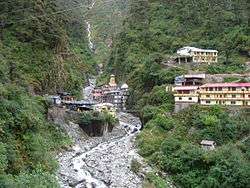Yamunotri Temple
| Yamunotri | |
|---|---|
|
Yamunotri temple and ashrams | |
 Yamunotri Location in Uttarakhand | |
| Name | |
| Proper name | Yamunotri Mandir |
| Devanagari | यमुनोत्री मंदिर |
| Geography | |
| Coordinates | 31°1′0.12″N 78°27′0″E / 31.0167000°N 78.45000°ECoordinates: 31°1′0.12″N 78°27′0″E / 31.0167000°N 78.45000°E |
| Country |
|
| State | Uttarakhand |
| District | Uttarkashi |
| Culture | |
| Primary deity | Goddess Yamuna |
| History and governance | |
| Date built | 19th century |
| Creator | Maharani Gularia of Jaipur |
Yamunotri Temple is situated in the western region of Garhwal Himalayas at an altitude of 3,291 metres (10,797 ft) in Uttarkashi district, Uttarakhand.[1] The temple is dedicated to Goddess Yamuna and has a black marble idol of the goddess.[2] The Yamunotri temple is a full day's journey from Uttarakhand's main towns — Rishikesh, Haridwar or Dehradun. The actual temple is only accessible by a 13 kilometres (8.1 mi) trek from the town of Hanuman Chatti and a 6 kilometres (3.7 mi) walk from Janki Chatti; horses or palanquins are available for rent. The hike from Hanuman Chatti to Yamunotri is very picturesque with beautiful views of a number of waterfalls. There are two trekking routes from Hanuman Chatti to Yamunotri, the one along the right bank proceeds via the Markandeya Tirth, where the sage Markandeya wrote the Markandeya Purana, the other route which lies on the left bank of the river goes via Kharsali, from where Yamunotri is a five or six hours climb away.[3]
History
Yamunotri temple has a shrine dedicated to the goddess. There is also an 18th-century temple at Gangotri, it was built by Amar Singh Thapa, it was damaged and re-innovated in the 19th century.[4] The temple has been destroyed twice by snow and floods before being rebuilt.[2][5] It is located on the backdrop of Bandarpunch.[6] The temple is part of the revered Char Dham pilgrimage circuit.[7]
Temple and vicinity
The temple opens on Akshaya Tritiya (May)[8] and closes on Yama Dwitiya (the second day after Diwali, November) for the winter.[9] A little ahead is the actual source of the river Yamuna which is at an altitude of about 4,421 metres (14,505 ft) approximately. Two hot springs are also present at Yamunotri offering relief to tired hikers at a height of 3,292 metres (10,801 ft), Surya Kund, has boiling hot water, while Gauri Kund, had tepid water suitable for bathing [3] The spring water is said to be hot enough to cook rice and potatoes.[10] Lodging at the temple itself is limited to a few small ashrams and guest-houses. Ritual duties such as the making and distribution of prasad (sanctified offerings) and the supervision of pujas (ritual venerations) are performed by the Uniyal family of pujaris (priests). Unique aspects of ritual practice at the site include hot springs where raw rice is cooked and made into prasad.
References
- ↑ Roma Bradnock, Robert Bradnock (2001). Indian Himalaya handbook: the travel guide. Footprint Travel Guides. p. 111. ISBN 1900949792.
- 1 2 Kapoor, Subodh (2002). The Indian encyclopaedia: biographical, historical, religious, administrative, ethnological, commercial and scientific. (Volume 5). Genesis Publishing Pvt Ltd. p. 1397. ISBN 8177552570.
- 1 2 Yamunotri Temple Uttarkashi district website.
- ↑ "The height of beauty". The Hindu Business Line. 6 August 2001. Retrieved 2 April 2012.
- ↑ Nair, Shantha N. (2007). The Holy Himalayas. Pustak Mahal. p. 75. ISBN 8122309674.
- ↑ Tyagi, Nutan (1991). Hill resorts of U.P. Himalaya,: a geographical study. Indus Publishing. p. 31. ISBN 8185182620.
- ↑ Bandopadhyay, Manohar (2010). Tourist destinations in India. Pinnacle Technology. p. 138. ISBN 9380944004.
- ↑ "Garhwal's Himalayan yatra". The Times of India. 14 June 2011. Retrieved 2 April 2012.
- ↑ "Kedarnath, Yamunotri shrines closed for winter". The Hindu. 30 October 2008. Retrieved 2 April 2012.
- ↑ Pushpendra K. Agarwal, Vijay P. Singh, Sharad Kumar Jain (2007). Hydrology and water resources of India. Springer. p. 344. ISBN 1402051794.
